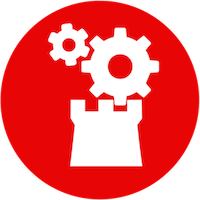20 Dec 2016
And so another year draws to a close. We would like to take the opportunity to wish all our clients, business partners, friends, diligent beta testers and other supporters a very happy holiday season.
The four of us are looking forward to spending some time with loved ones after a year that can only be described as somewhat frantic (in a good way). In addition to a lot of consulting and coding work, commercially, 2016 looked like this (expressed in a smattering of bullet points):
Phew! Thank you for reading, and we hope you have a restful break. We also look forward to working with many of you in 2017.
The LDC Via team
06 Dec 2016
Last week Julian was pleased to be asked to speak at the autumn ISBG conference in Oslo. The topic was ‘Finding your way out of the Domino maze’, a wide-ranging overview of the challenges that need to be overcome when migrating applications away from Domino, the meanings that ‘Migration’ could have, some of the key technologies to look at including NoSQL, and a brief overview of how LDC Via fits into that picture.
View or download the presentation at these locations:
06 Dec 2016
In all the general busy-ness (coding, designing and earning a living), we’re conscious that there are lots of things to tell you.
2016 has been an extremely busy year for LDC Via: various technical challenges as one would expect. New products to launch — more on KEEP.WORKS in a separate post — together with meetings to chair, proposals to write, and partnerships to forge!
It is of the latter we wish to speak today. Some months ago, we opened discussions with our good friend Andrew Magerman, and these quickly bore fruit: Swiss LDC Via.
As many cloud aficionados are aware, hosting data outside national borders can be a massive issue for Swiss organisations – especially local and national government – and this is where Via hosted in Switzerland comes in. We invite you to explore the service and read more about it at Andrew’s site: Host your migrated Domino Data in Switzerland at ch.ldcvia.com.
29 Nov 2016
Our very own Julian Woodward will be presenting at the ISBG meeting in Oslo this week. You can read more about his session at the relevant agenda page, if your Norwegian is up to scratch!
Julian Woodward, Finding your way out of the Domino maze
In English:
Finding your way out of the Domino maze - LDC Via
Migrating applications away from Domino is a complex problem, and there is no one-size-fits-all solution. In this session Julian Woodward will look at how to scope and plan a migration, examine the technical and human challenges you’ll need to overcome along the way, and compare some of the approaches you can take.
29 Sep 2016
Just 2 weeks into our beta of KEEP.WORKS, and we want our lovely beta testers to know we’ve been listening to their feedback. So, version 1.0.79 went live this week, with the following splendid new features.
Database icons
A workspace full of square tiles is a thing of zen-like beauty, of course. But sometimes, you need to jazz it up a little with images of your own, to make you feel at home. So it’s now possible to add an image to a database, and that image will display both on the database icon on the KEEP.WORKS workspace, and also within every screen inside the application. And because we don’t like to do things by halves, not only can you upload any image you like, but you can also crop, zoom and rotate it. You can even export it (and, yes, PNG files are supported. “In” joke).
Database settings
Each database on the workspace now has a gear icon at the top right, to allow you to quickly get to its settings page. From there you can add new users, look at stats, change the title, and — yes — set up a database icon.
Stylesheets
You can now enter some css into the global settings area, which will then be loaded as the final stylesheet on every page in KEEP.WORKS. So you can override any of our default CSS settings to turn your KEEP.WORKS instance into a Frankenstein’s monster of bright pink comic sans on a canary yellow background. Or alternatively you could do something useful with it, like adapt our colour and font scheme to match your corporate standards. But that wouldn’t be nearly as much fun.
Betterness
Various little bugs have been squished and wiped away. That’s what a beta phase is for.
If you want to be alerted when we open KEEP.WORKS up to a wider audience, simply email [email protected].
